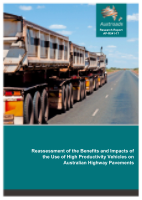Freight

- Publication no: AP-R541-17
- ISBN: 978-1-925451-63-4
- Published: 18 April 2017
- PDF (free) Download
This report reassesses the benefits and impacts of using High Productivity Vehicles (HPVs) and proposes a method to consistently quantify pavement vertical loading of an individual vehicle design.
Australia’s Performance Based Standards (PBS) scheme, formalised in 2007, does not include a performance requirement for pavement vertical loading. This project makes progress towards establishing such a standard.
The method comprises a number of steps to evaluate the impacts and benefits of the introduction of HPVs to a road network. The method presents vehicle comparison metrics for vertical pavement loading. These are offset against calculations to quantify the productivity, safety and environmental benefits achievable through the introduction of HPVs.
Further work is required to incorporate this report’s contents into a PBS rule, particularly with regard to the creation of a pricing scheme capable of transferring a portion of productivity-related savings to road managers for the increased cost of road maintenance.
- Summary
- 1. Introduction
- 1.1. Background
- 1.2. Project Scope
- 1.3. Objectives
- 1.4. Report Structure
- 1.5. Freight Demand, HPVs and Road Pricing
- 2. Literature Review
- 2.1. Summary
- 2.2. Review of Current PBS Rules: Vertical Loading Standard
- 2.3. Review of the ‘Green-Line’ PWAM
- 2.4. Quantifying the Benefits of HPVs
- 2.5. Impacts of PBS Pavement Vertical Loading Standards at Network Level
- 2.6. Guide to Pavement Technology Part 2: Pavement Structural Design
- 2.7. National Steer Axle Mass Limits
- 2.8. Development of the FAMLIT Model
- 3. Proposed Vehicle Comparison Method
- 3.1. Comparison Metrics
- 3.2. Required Data
- 3.3. Proposed Comparison Process
- 3.4. Assumptions
- 3.5. Reference Vehicles
- 3.6. Case Studies
- 3.6.1. Case Study Results Summary
- 3.6.2. Example 1 – Tri-axle Truck and Quad-axle Dog
- 3.6.3. Example 2 – Tri-axle Truck and Five-axle Dog
- 3.6.4. Summary
- 4. Quantification of Benefits and Costs
- 4.1. Quantifying Productivity
- 4.1.1. Road User Effects
- 4.1.2. Vehicle Operating Costs
- 4.1.3. VOC Model Selection
- 4.1.4. Travel Time Costs (Labour and Delays)
- 4.1.5. Example Process for Quantifying Productivity
- 4.1.6. Key Assumptions for Productivity
- 4.2. Quantifying Safety
- 4.2.1. Crash Rates
- 4.2.2. Crash Costs
- 4.2.3. Proposed Method
- 4.2.4. Example Process for Quantifying Safety
- 4.2.5. Key Assumptions for Safety
- 4.3. Quantifying Emissions
- 4.3.1. Proposed Method
- 4.3.2. Example Process for Quantifying Emissions
- 4.3.3. Key Assumptions
- 4.4. Quantifying Pavement Impacts
- 4.4.1. Load Wear Cost Model Background
- 4.4.2. The FAMLIT Model
- 4.4.3. Alternative Applications Options
- 4.4.4. Example Process for Quantifying Pavement Impact
- 4.5. Overall Impact
- 5. Discussion and Limitations
- 5.1. Availability of VOC Estimates
- 5.2. Proposed Access Decision Method
- 5.3. Implementation Options
- 6. Findings and Conclusion
- 6.1. Limitations
- 6.2. Next Steps
- 6.2.1. Quantification of Safety
- 6.2.2. Estimate of VOC for Vehicle Configurations
- 6.2.3. Availability of Road Condition and Maintenance Data
- 6.2.4. Implementation of the Assessment Method
- Part 1: Determine vehicle comparison metrics
- Part 2: Quantification of other benefits
- Part 3: Quantification of pavement impacts
- References
- Appendix A Review of Key Publications
- A.1 Review of Current PBS Rules: Vertical Loading Standard
- A.2 Review of the ‘Green-Line’ PWAM
- A.3 Review of Other Key Research Reports
- A.3.1 Quantifying the Benefits of High Productivity Vehicles
- A.3.2 Impacts of PBS Pavement Vertical Loading Standards at Network Level
- A.3.3 Guide to Pavement Technology Part 2: Pavement Structural Design
- A.3.4 National Steer Axle Mass Limits
- A.3.5 Deploy and Refine the Road Wear Modelling Methodologies – FAMLIT Final Report
- Appendix B Comparison with The Green Line Method
- Appendix C Vehicle Comparison Case Studies
- C.1 Case Study 1 – Six-axle Semi-trailer
- C.2 Case Study 2 – Seven-axle Semi-trailer
- C.3 Case Study 3 – Seven-axle Semi-trailer
- C.4 Case Study 4 – Seven-axle Semi-trailer
- C.5 Case Study 5 – Tri-axle Truck and Tri-axle Dog
- C.6 Case Study 6 – Three-axle Truck and Four-axle Dog
- C.7 Case Study 7 – Tri-axle Truck and Five-axle Dog
- C.8 Case Study 8 – Eight-axle Tri-tandem B-double
- C.9 Case Study 9 – Nine-axle Tri-tri B-double
- C.10 Case Study 10 – B-double Quad-quad
- C.11 Case Study 11 – B-double Quad-quad
- C.12 Case Study 12 – B-double Quad-quad
- C.13 Case Study 13 – Nine-axle Tandem A-double
- C.14 Case Study 14 – BA-triple
- C.15 Case Study 15 – BA-triple
- C.16 Case Study 16 – AB-double
- Appendix D Options for Quantifying Safety
- Benefits of advanced technologies
- Crash risk linked to PBS results
- Crash rates
- Crash costs
- Appendix E Options for Quantifying Emissions
- Appendix F Road Characteristics
